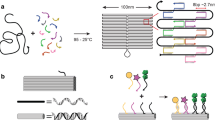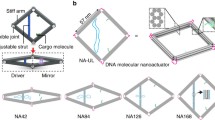Abstract
Increasingly detailed structural1 and dynamic2,3 studies are highlighting the precision with which biomolecules execute often complex tasks at the molecular scale. The efficiency and versatility of these processes have inspired many attempts to mimic or harness them. To date, biomolecules have been used to perform computational operations4 and actuation5, to construct artificial transcriptional loops that behave like simple circuit elements6,7 and to direct the assembly of nanocrystals8. Further development of these approaches requires new tools for the physical and chemical manipulation of biological systems. Biomolecular activity has been triggered optically through the use of chromophores9,10,11,12,13,14, but direct electronic control over biomolecular ‘machinery’ in a specific and fully reversible manner has not yet been achieved. Here we demonstrate remote electronic control over the hybridization behaviour of DNA molecules, by inductive coupling of a radio-frequency magnetic field to a metal nanocrystal covalently linked to DNA15. Inductive coupling to the nanocrystal increases the local temperature of the bound DNA, thereby inducing denaturation while leaving surrounding molecules relatively unaffected. Moreover, because dissolved biomolecules dissipate heat in less than 50 picoseconds (ref. 16), the switching is fully reversible. Inductive heating of macroscopic samples is widely used17,18,19, but the present approach should allow extension of this concept to the control of hybridization and thus of a broad range of biological functions on the molecular scale.



Similar content being viewed by others
References
Ban, N., Nissen, P., Hansen, J., Moore, P. B. & Steitz, T. A. The complete atomic structure of the large ribosomal subunit at 2.4 Å resolution. Science 289, 905–920 (2000).
Deniz, A. A. et al. Single-molecule protein folding: Diffusion fluorescence resonance energy transfer studies of the denaturation of chymotrypsin inhibitor 2. Proc. Natl Acad. Sci. USA 97, 5179–5184 (2000).
Davenport, R., Wuite, G., Landick, R. & Bustamante, C. Single-molecule study of transcriptional pausing and arrest by E. coli RNA polymerase. Science 287, 2497–2500 (2000).
Winfree, E., Liu, F., Wenzler, L. & Seeman, N. Design and self-assembly of two-dimensional DNA crystals. Nature 394, 539–44 (1998).
Yurke, B. et al. A DNA-fuelled molecular machine made of DNA. Nature 406, 605–608 (2000).
McAdams, H. H. & Arkin, A. Gene regulation: towards a circuit engineering discipline. Curr. Biol. 10, R318–R320 (2000).
Elowitz, M. B. & Leibler, S. A synthetic oscillatory network of transcriptional regulators. Nature 403, 335–338 (2000).
Whaley, S. R., English, D. S., Hu, E. L., Barbara, P. F. & Belcher, A. M. Selection of peptides with semiconductor binding specificity for directed nanocrystal assembly. Nature 405, 665–668 (2000).
Telford, J. R., Wittung-Stafshede, P., Gray, H. B. & Winkler, J. R. Protein folding triggered by electron transfer. Acc. Chem. Res. 31, 755–763 (1998).
Monroe, W. T., McQuain, M. M., Chang, M. S., Alexander, J. S. & Haselton, F. R. Targeting expression with light using caged DNA. J. Biol. Chem. 274, 20895–20900 (1999).
Asanuma, H., Yoshida, T., Ito, T. & Komiyama, M. Photo-responsive oligonucleotides carrying azobenzene at the 2’-position of uridine. Tetrahedr. Lett. 40, 7995–7998 (1999).
Liu, D., Karanicolas, J., Yu, C., Zhang, Z. & Woolley, G. A. Site-specific incorporation of photoisomerizable azobenzene groups into Ribonuclease S. Bioorg. Med. Chem. Lett. 7, 2677–2680 (1997).
Haupts, U., Tittor, J. & Oesterhelt, D. Closing in on bacteriorhodopsin: progress in understanding the molecule. Annu. Rev. Biophys. Biomol. Struct. 28, 367–99 (1999).
Ashkenazi, G., Ripoll, D. R., Lotan, N. & Scheraga, H. A. A molecular switch for biochemical logic gates: Conformational studies. Biosens. Bioelectron. 12, 85–95 (1997).
Hamad-Schifferli, K., Schwartz, J. J., Santos, A. T., Zhang, S. & Jacobson, J. M. in Mater. Res. Soc. Proc. (eds Hahn, H. W., Feldheim, D. L., Kubiak, C. P., Tannenbaum, R. & Siegel, R. W.) Y8.43 (MRS, San Francisco, 2001).
Lian, T., Locke, B., Kholodenko, Y. & Hochstrasser, R. M. Energy flow solute to solvent probed by femtosecond IR spectroscopy: malachite green and heme protein solutions. J. Phys. Chem. 98, 11648–11656 (1994).
Orfeuil, M. Electric Process Heating: Technologies/ Equipment/ Applications (Battelle Press, Columbus, Ohio, 1987).
Zinn, S. & Semiatin, S. L. Elements of Induction Heating, Design Control, and Applications (ASM International, Materials Park, Ohio, 1988).
Hergt, R. et al. Physical limits of hyperthermia using magnetite fine particles. IEEE Trans. Magn. 34, 3745–3754 (1998).
Bonnet, G., Tyagi, S., Libchaber, A. & Kramer, F. R. Thermodynamic basis of the enhanced specificity of structured DNA probes. Proc. Natl Acad. Sci. USA 96, 6171–6176 (1999).
Taton, A. T., Mirkin, C. A. & Letsinger, R. L. Scanometric DNA array detection with nanoparticle probes. Science 289, 1757–1760 (2000).
Loweth, C. J., Caldwell, W. B., Peng, X., Alivisatos, A. P. & Schultz, P. G. DNA-based assembly of gold nanocrystals. Angew. Chem. Int. Edn Engl. 38, 1808–1812 (1999).
Mattoussi, H. et al. Self-assembly of CdSe-ZnS quantum dot bioconjugates using an engineered recombinant protein. J. Am. Chem. Soc. 122, 12142–12150 (2000).
Zanchet, D., Micheel, C. M., Parak, W. J., Gerion, D. & Alivisatos, A. P. Electrophoretic isolation of discrete Au nanocrystal/DNA conjugates. Nanoletters 1, 32–35 (2001).
Bonnet, G., Krichevsky, O. & Libchaber, A. Kinetics of conformational fluctuations in DNA hairpin-loops. Proc. Natl Acad. Sci. USA 95, 8602–8606 (1998).
Cantor, C. R. & Schimmel, P. Biophysical Chemistry (Freeman, San Francisco, 1980).
Mao, C., LaBean, T. H., Reif, J. H. & Seeman, N. C. Logical computation using algorithmic self-assembly of DNA triple-crossover molecules. Nature 407, 493–496 (2000).
Probst, J. C. Antisense oligodeoxynucleotide and ribozyme design. Methods 22, 271–281 (2000).
Reardon, J. E. & Frey, P. A. Synthesis of undecagold cluster molecules as biochemical labeling reagents. 1. Monoacyl and mono[N-succinimidooxy)succinyl] undecagold clusters. Biochemistry 23, 3849–3856 (1984).
Hermanson, G. T. Bioconjugate Techniques (Academic, San Diego, 1996).
Acknowledgements
We thank N. Afeyan, E. Lander and P. Matsudaira for discussions in the early stages of this work, and J.P. Shi for comments on the experimental work. This work was supported by DARPA and the MIT Media Lab TTT consortium.
Author information
Authors and Affiliations
Corresponding author
Supplementary information
Rights and permissions
About this article
Cite this article
Hamad-Schifferli, K., Schwartz, J., Santos, A. et al. Remote electronic control of DNA hybridization through inductive coupling to an attached metal nanocrystal antenna. Nature 415, 152–155 (2002). https://doi.org/10.1038/415152a
Received:
Accepted:
Issue Date:
DOI: https://doi.org/10.1038/415152a
- Springer Nature Limited
This article is cited by
-
Photothermal Heating of Au Nanorods and Nanospheres: Temperature Characteristics and Strength of Convective Forces
Plasmonics (2023)
-
Radiofrequency remote control of thermolysin activity
Scientific Reports (2021)
-
Extracellular matrix-based materials for regenerative medicine
Nature Reviews Materials (2018)
-
Heat guiding and focusing using ballistic phonon transport in phononic nanostructures
Nature Communications (2017)





